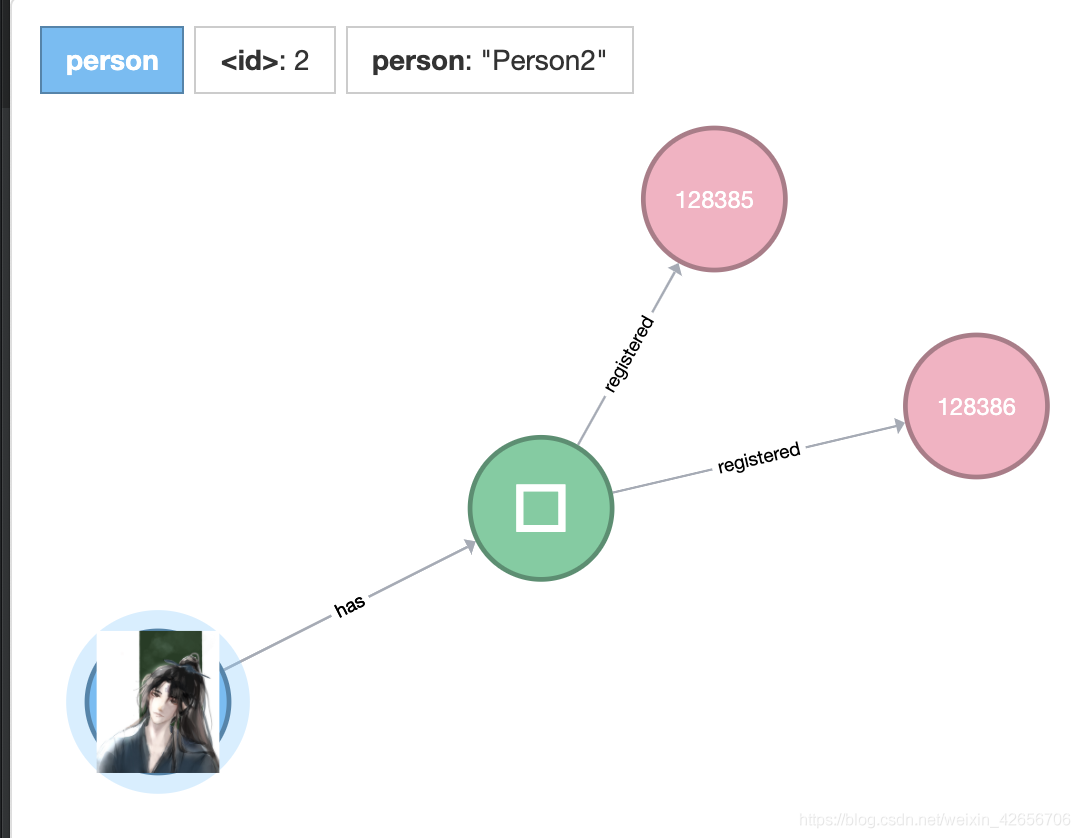基于d3.js/neovis.js/neod3.js实现链接neo4j图形数据库的图像化显示功能
目录
- 一、使用d3.js
- 二、 neo4jd3.js
- 三、neovis.js
一、基于D3.js (自由度高,写起来麻烦)
二、基于neovis.js (基于d3库,简洁,但样式固定,自由度低。)
三、基于neo4jd3.js (融合neovis与d3,数据格式可用d3\neo4j的,或根据需求自己重写方法) https://github.com/eisman/neo4jd3
Svg 不推荐在HTML4和XHTML中使用(但在HTML5允许)
一、使用d3.js
效果:

1.引入官方js

定义背景/图片大小
用svg绘制背景、节点、线条、箭头。
1.请求json 数据(处理成可用等d3格式{node:{ },relaton:{source: ,target: ,type: })
2. d3默认按索引链接结点,要强制改为通过id链接它们(myerror: 注意 === 与 == 的不同,数据类型会导致错误)
3.构造力导向布局
力布局使用:https://github.com/d3/d3/wiki/%E5%8A%9B%E5%B8%83%E5%B1%80
D3.layout.force( )构造力导向布局,force.start( ) 启动模拟;
force.tick触发仿真第一步(如更新节点的x和y属性);
force.drag( )交互式拖动;
4.Select元素,并操作select,据需求自定义样式属性()。
选择器使用参考:https://github.com/d3/d3/wiki/%E9%80%89%E6%8B%A9%E5%99%A8#append
https://github.com/d3/d3/wiki/%E9%80%89%E6%8B%A9%E5%99%A8
【D3中,select 返回第一个匹配的元素,selectAll遍历次序中所有匹配的元素。】
代码:
<html>
<head>
<meta charset="utf-8">
<title>Force</title>
<style>
.nodetext {
font-size: 12px ;
font-family: SimSun;//字体
fill:#000000;
}
.linetext {
/*font-family: SimSun;*/
fill:#1f77b4;
fill-opacity:0.0;
.circleImg {
stroke: #ff7f0e;
stroke-width: 1.5px;
</style></head>
<body>
<script src="http://d3js.org/d3.v3.min.js" charset="utf-8"></script>
<script src="https://cdnjs.cloudflare.com/ajax/libs/d3/3.5.5/d3.min.js"></script>
<script src="https://code.jquery.com/jquery-3.2.1.min.js"></script>
<script>
var width = 900;
var height = 800;
var img_w = 77;
var img_h = 80;
var radius = 30; //圆形半径
var svg = d3.select("body")
.append("svg")
.attr("width",width)
.attr("height",height);
var edges = [];
d3.json("my.json",function(error,root){
if( error ){
return console.log(error);
console.log(root);
//默认按索引链接结点,我强制改成通过id链接它们。
root.edges.forEach(function (e) {
var sourceNode = root.nodes.filter(function (n) {
return n.id === e.source;
})[0],
targetNode = root.nodes.filter(function (n) {
return n.id === e.target;
})[0];
edges.push({
source: sourceNode,
target: targetNode,
relation: e.type
})
});
console.log(edges)
//D3力导向布局
var force = d3.layout.force()
.nodes(root.nodes)
.links(edges)
.size([width,height])
.linkDistance(200)
.charge(-1500)
.start();
var defs = svg.append("defs");
var arrowMarker = defs.append("marker")
.attr("id","arrow")
.attr("markerUnits","strokeWidth")//图最前端大小
.attr("markerWidth","15")//标识长宽
.attr("markerHeight","15")
.attr("viewBox","0 0 12 12")//坐标系区域
.attr("refX","17")
.attr("refY","6")
.attr("orient","auto");//方向
var arrow_path = "M2,2 L10,6 L2,10 L6,6 L2,2";
arrowMarker.append("path")
.attr("d",arrow_path)
.attr("fill","#ccc");
//边
var edges_line =svg.selectAll("line")
.data(edges)
.enter()
.append("line")
.attr("class","line")
.style("stroke","#ddd")
.style("linewidth",2)
.attr("marker-end","url(#arrow)")
.style("stroke-width",3);
//边上的文字(人物之间的关系)
var edges_text = svg.selectAll(".linetext")
.append("text")
.attr("class","linetext")
.text(function(d){
return d.relation;
})
.style("fill-opacity",1.0);//不透明度
// 圆形图片节点(人物头像)
var nodes_img = svg.selectAll("image")
.data(root.nodes)
.append("circle")
.attr("class", "circleImg")
.attr("r", radius)
.attr("fill", function(d, i){
//创建圆形图片
var defs = svg.append("defs").attr("id", "imgdefs")
var catpattern = defs.append("pattern")
.attr("id", "catpattern" + i)
.attr("height", 1)
.attr("width", 1)
catpattern.append("image")
.attr("x", - (img_w / 2 - radius))
.attr("y", - (img_h / 2 - radius))
.attr("width", img_w)
.attr("height", img_h)
.attr("xlink:href", d.labels)
return "url(#catpattern" + i + ")";
// .on("mouseover",function(d,i){
// //显示连接线上的文字
// edges_text.style("fill-opacity",function(edge){
// if( parseInt(edge.source) === d || parseInt(edge.target) === d ){
// return 1.0;
// }
// });
// })
// .on("mouseout",function(d,i){
// //隐去连接线上的文字
// if( edge.source === d || edge.target === d ){
// return 0.0;
.call(force.drag);
var text_dx = -20;
var text_dy = 20;
var nodes_text = svg.selectAll(".nodetext")
.style("stroke","#ff7f0e")
.attr("class","nodetext")
.attr("dx",text_dx)
.attr("dy",text_dy)
var uservalue = d.properties.username;
var personvalue = d.properties.person;
var phonevalue = d.properties.phone;
if ( uservalue == undefined ){
uservalue = "";
}
if(personvalue == undefined){
personvalue = "";
if (phonevalue == undefined){
phonevalue = "";
return uservalue + phonevalue + personvalue;
});
force.on("tick", function(){
//限制结点的边界
root.nodes.forEach(function(d,i){
d.x = d.x - img_w/2 < 0 ? img_w/2 : d.x ;
d.x = d.x + img_w/2 > width ? width - img_w/2 : d.x ;
d.y = d.y - img_h/2 < 0 ? img_h/2 : d.y ;
d.y = d.y + img_h/2 + text_dy > height ? height - img_h/2 - text_dy : d.y ;
//更新连接线的位置
edges_line.attr("x1",function(d){ return d.source.x; });
edges_line.attr("y1",function(d){ return d.source.y; });
edges_line.attr("x2",function(d){ return d.target.x; });
edges_line.attr("y2",function(d){ return d.target.y; });
//更新连接线上文字的位置
edges_text.attr("x",function(d){ return (d.source.x + d.target.x) / 2 ; });
edges_text.attr("y",function(d){ return (d.source.y + d.target.y) / 2 ; });
//更新结点图片和文字
nodes_img.attr("cx",function(d){ return d.x });
nodes_img.attr("cy",function(d){ return d.y });
nodes_text.attr("x",function(d){ return d.x });
nodes_text.attr("y",function(d){ return d.y + img_w/2; });
});
</script>
</body>
</html>
mydata.json
{
"nodes": [{
"id": "2",
"labels": "./image/wode.png",
"properties": {
"person": "Person2"
}
}, {
"id": "58688",
"phone": "85266978333"
"id": "128386",
"username": "Samuel_lee"
}],
"edges": [{
"id": "23943",
"type": "has",
"startNode": "2",
"endNode": "58688",
"properties": {},
"source": "2",
"target": "58688"
"id": "94198",
"type": "registered",
"startNode": "58688",
"endNode": "128386",
"source": "58688",
"target": "128386"
}]
}
二、 neo4jd3.js
https://github.com/eisman/neo4jd3
效果:

与neovis.js类似,根据d3/neo4j的数据格式,将数据传入,根据需求渲染结点图像关系,但样式固定。
可以重写js中的数据与方法。
在这里,出现了问题:我在js中修改的方法无法被使用。
根据排查,最后发现在代码末尾有一行注释:

源映射是用来为压缩后的代码调试提供方便的,为了提高性能,很多站点都会先压缩 JavaScript 代码然后上线,
但如果代码运行时出现错误,浏览器只会显示在已压缩的代码中的位置,很难确定真正的源码错误位置。
要更改js记得将这行注释删除。
<!doctype html>
<html>
<head>
<meta charset="utf-8">
<meta http-equiv="X-UA-Compatible" content="IE=edge,chrome=1">
<meta name="description" content="">
<meta name="viewport" content="width=device-width">
<title>neo4jd3.js</title>
<link rel="stylesheet" href="css/bootstrap.min.css" rel="external nofollow" >
<link rel="stylesheet" href="css/font-awesome.min.css" rel="external nofollow" >
<link rel="stylesheet" href="css/neo4jd3.min.css?v=0.0.1" rel="external nofollow" >
<script src="js/d3.min.js"></script>
<script src="js/2.js?v=0.0.2"></script>
<style>
body,
html,
.neo4jd3 {
height: 100%;
overflow: hidden;
}
</style>
</head>
<body>
<div id="neo4jd33"></div>
<!-- Scripts -->
<script type="text/javascript" >
function init() {
var neo4jd3 = new Neo4jd3('#neo4jd33', {
icons: {
},
images: {
'person': 'img/twemoji/wode.png',
minCollision: 50,
neo4jDataUrl:'./json/mydata.json',
nodeRadius: 30,
zoomFit: false
});
window.onload = init;
</script>
<script>
</body>
</html>
三、neovis.js

详细使用文档见:
https://www.npmjs.com/package/neovis.js
https://github.com/neo4j-contrib/neovis.js#readme
Neovis.js 需要链接 neo4j 的bolt地址,并书写cypher语句获取查询结果。
创建一个div,在其中制定οnlοad=“draw( )”,然后自己定义draw( )。
使用简单,但模板样式固定。
function draw() {
var config = {
container_id: "viz",
server_url:"bolt://xxxxxxxx",
server_user: "",
server_password: "",
labels: {
"person": {
"caption": "person",
},
"phone":{
"caption": "phone",
},
"zello":{
"caption": "username",
}
relationships: {
"has": {
"thickness": 0.003,
"caption": true
,"registered":{
initial_cypher: "MATCH (n) RETURN n LIMIT 25",
arrows: true
};
viz = new NeoVis.default(config);
console.log(viz);
viz.render();
}
到此这篇关于基于d3.js/neovis.js/neod3.js实现链接neo4j图形数据库的图像化显示功能的文章就介绍到这了,更多相关neo4j图像化显示内容请搜索我们以前的文章或继续浏览下面的相关文章希望大家以后多多支持我们!

